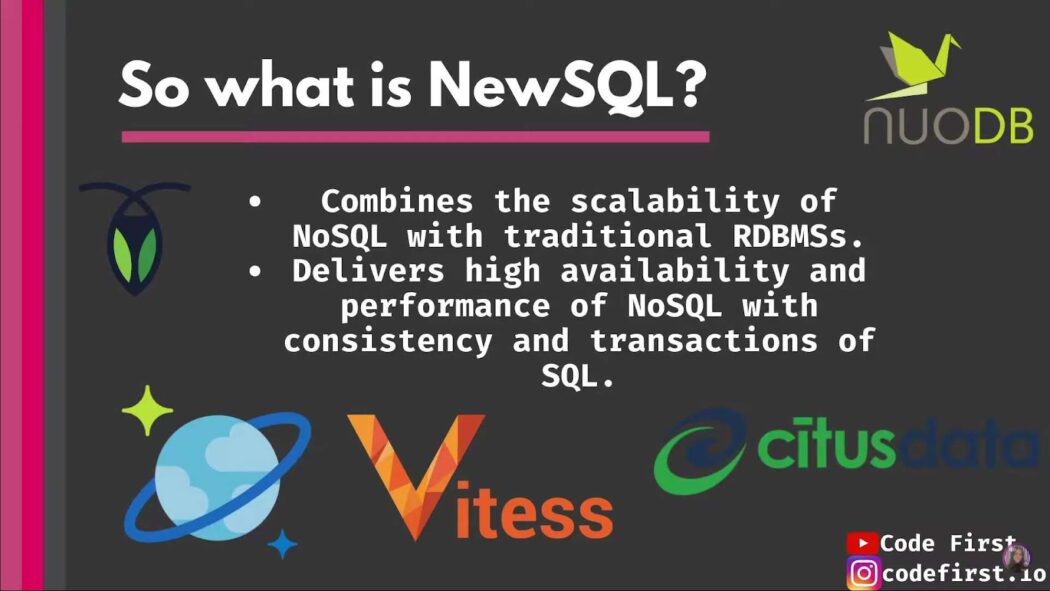Database management systems (DBMS) constitute the fundamental infrastructure underpinning the majority of contemporary software applications. They function as the central conduit connecting end-users to the underlying data in these applications. Through their vigilant oversight of data integrity, robust security measures, and facilitation of data accessibility, DBMSs assume a paramount role within numerous organizational contexts. This article embarks on an in-depth exploration of several frequently employed database management systems, unveiling their distinctive attributes, benefits, and application scenarios.
Relational Database Management Systems (RDBMS)
RDBMSs are the cornerstone of modern data management, designed based on the groundbreaking relational model introduced by Edgar Codd in the 1970s. This model revolutionized how info is organized and accessed, using tables (also called relations) to elegantly structure and store information, while utilizing the powerful Structured Query Language (SQL) for seamless retrieval.
Key Features:
- Structured: RDBMSs excel in structuring data by using tables, which consist of rows and columns. This tabular format simplifies info organization, making it easy to understand and manage;
- Data Integrity: These systems enforce integrity through various constraints such as primary and foreign keys. This ensures that info remains accurate, consistent, and free from anomalies;
- ACID Compliance: RDBMSs adhere to the principles of ACID – Atomicity, Consistency, Isolation, and Durability. This means transactions are reliably processed, errors are minimized, and it remains robust even in the face of system failures.
Popular RDBMS Systems:
- MySQL: Known for its open-source nature and excellent performance, MySQL is a top choice for web applications and data-driven websites;
- PostgreSQL: Renowned for its advanced features and extensibility, PostgreSQL is a versatile option suitable for a wide range of applications;
- Microsoft SQL Server: Widely used in the Windows ecosystem, SQL Server offers robust enterprise-grade features;
- Oracle Database: A powerhouse in this industry, Oracle excels in large-scale, mission-critical applications.
Use Cases:
RDBMSs find applications across diverse domains, from small-scale projects to large enterprises:
- CRM (Customer Relationship Management): Manage customer info efficiently, ensuring quick access to vital information for improved customer service;
- ERP (Enterprise Resource Planning): Streamline business processes by integrating data from various departments, enhancing overall efficiency;
- Financial Systems: Maintain financial records accurately, enabling seamless financial analysis and reporting.
NoSQL Databases
In response to the growing demand for flexibility and scalability in modern applications, NoSQL emerged as a dynamic alternative to RDBMS. Unlike their structured counterparts, NoSQL are adaptable and can efficiently handle diverse info structures, making them invaluable for web-scale applications.
Key Features:
- Flexibility: NoSQL is designed to handle a wide range of data types, including JSON, XML, and more. This flexibility makes them suitable for applications where formats can evolve rapidly;
- Scalability: NoSQL is engineered for horizontal scalability. This means they can efficiently expand to handle large datasets and high traffic, making them ideal for growing applications;
- Schema-less: Unlike RDBMSs that require a fixed schema, NoSQL is schema-less. This allows for agile development, as it can be inserted without predefined structures.
Subtypes & Popular Systems:
NoSQL come in various subtypes, each tailored to specific use cases:
- Document: MongoDB and CouchDB excel at handling semi-structured info, making them suitable for content management systems and document-oriented applications;
- Columnar: Cassandra and HBase are optimized for storing and processing large amounts of it, making them ideal for real-time analytics and big data applications;
- Key-Value: Redis and Riak are perfect for caching and fast retrieval of data, which is crucial in applications like e-commerce and gaming;
- Graph: Neo4j and OrientDB specialize in managing complex relationships, making them indispensable for social networks and recommendation engines.
Use Cases:
NoSQL shine in applications requiring rapid scaling and flexibility:
- Social Media Platforms: NoSQL handle the unpredictable and massive information flow encountered in social networks, ensuring seamless user experiences;
- Content Management Systems: The schema-less nature of NoSQL allows for effortless content adaptation and management in dynamic environments.
Object-Oriented Database Management Systems (OODBMS)
In the realm of data management, OODBMS are a unique fusion of object-oriented programming and traditional systems. These sophisticated systems don’t merely store info; they encapsulate it into meaningful objects, providing an elegant and intuitive approach to data handling. Let’s delve deeper into the world of OODBMS and discover their remarkable features, popular systems, and use cases.
Features of OODBMS
- Encapsulation: OODBMS masterfully bundles info and its related operations into cohesive units known as objects. This encapsulation ensures that it is neatly organized and maintains its integrity, making it easier to manage complex datasets;
- Inheritance: OODBMS inherits a fundamental concept from object-oriented programming – the ability for objects to inherit properties and behaviors. This powerful feature simplifies information modeling and encourages code reusability;
- Polymorphism: OODBMS promotes the concept of polymorphism, allowing a single interface to be used for different info types. This flexibility streamlines it manipulation and opens the door to versatile application development.
Popular OODBMS Systems
- ObjectDB: Known for its exceptional performance and support for Java-based applications, ObjectDB is a top choice for developers seeking an OODBMS solution;
- Versant Object Database: It is favored for its scalability and high-performance capabilities, making it an ideal choice for applications with demanding data needs.
Use Cases for OODBMS
- Computer-Aided Design: OODBMS excels in managing the intricate data structures required for CAD software, providing efficient storage and retrieval of design components;
- Multimedia Systems: Multimedia applications benefit from OODBMS’s ability to handle various media formats, ensuring smooth content management;
- Simulation Applications: Simulations often involve intricate case dependencies, and OODBMS’s encapsulation and inheritance features simplify these complexities.
In-Memory Databases (IMDB)
IMDB represent a revolution in the world of info storage and retrieval. These boldly eschew traditional disk-based storage in favor of harnessing the blazing speed and accessibility of a computer’s main memory. In this exploration, we will uncover the advantages, features, popular systems, and diverse use cases of IMDBs.
Features of IMDB
- High-Speed Access: IMDBs are renowned for their lightning-fast case access. With it residing in the system’s main memory, the need for disk I/O is eliminated, resulting in dramatically reduced info retrieval times;
- Volatility: IMDBs embrace volatility, and this is a critical consideration. Since primary storage is memory, measures for information persistence are essential. Regular data backup and recovery strategies are paramount to ensure it durability;
- Concurrency Control: IMDBs employ efficient mechanisms to handle simultaneous data operations. This concurrency control ensures that multiple users or processes can interact with the information without causing conflicts or inconsistencies.
Popular IMDB Systems
- Redis: Redis, often associated with NoSQL, is a versatile IMDB known for its simplicity and robust caching capabilities. It’s widely adopted in various applications, including real-time analytics;
- SAP HANA: SAP’s HANA is a heavyweight in the IMDB arena. It’s prized for its ability to handle massive datasets and complex queries, making it a staple in enterprise solutions;
- MemSQL: MemSQL is a modern IMDB that combines the strengths of relational with the speed of in-memory processing. It’s an excellent choice for high-performance applications.
Use Cases for IMDB
IMDBs offer an unparalleled advantage in scenarios where rapid info access and low-latency performance are paramount. Consider implementing IMDB for:
- High-Frequency Trading Platforms: In the world of finance, split-second decisions are crucial. IMDBs ensure that trading data is accessible at lightning speed, facilitating high-frequency trading strategies;
- Real-Time Analytics: Businesses rely on real-time insights for decision-making. IMDBs provide the necessary speed for processing and analyzing vast amounts of information in real time.
Distributed Database Systems
DDS are advanced data storage structures that compartmentalize and store information across several distinct locations. This could mean a myriad of servers within one singular information facility or a sprawling network of centers scattered globally.
Characteristics:
- Data Replication: One of the main pillars of distributed info is replication. It ensures uniformity and congruence throughout all participating nodes. By creating multiple copies of it and ensuring they’re synchronized, it helps in swift recovery and accurate information retrieval;
- Fault Tolerance: These systems are designed with resilience in mind. Should one node or section become compromised or face an outage, the entire system doesn’t crumble. Instead, other nodes take on the workload, ensuring uninterrupted functionality;
- Transparency: Despite its complex backend operations, distributed databases present a façade of simplicity. To the end-users, it often appears and behaves like a singular, cohesive database, making interactions smooth and uncomplicated.
Renowned DDS:
- Apache Cassandra: Apart from being a distributed database, it’s also categorized under NoSQL. Known for its performance and scalability, it’s used by giants like Apple and Netflix;
- CockroachDB: Renowned for its strong consistency and scalability, CockroachDB offers seamless cloud migrations;
- Google Spanner: Combining the best of both worlds, it provides the consistency of traditional with the scalability and distributed nature of NoSQL systems.
Applications:
Distributed databases are indispensable for online shopping portals, ensuring real-time info availability irrespective of the global location of the user. Furthermore, they’re quintessential for any system prioritizing durability and resilience against information-related calamities.
NewSQL Databases
NewSQL emerged as a hybrid solution, melding the benefits of the age-old RDBMS systems with the scalability attributes of NoSQL systems. Their goal? To offer the expansive scalability that NoSQL is loved for while staunchly upholding the ACID tenets that traditional RDBMS swear by.

Characteristics:
- Scalability: Unlike traditional databases that scale up, NewSQL is designed to scale out. By distributing cases efficiently across nodes, they ensure that expanding information requirements don’t compromise system performance;
- SQL Compatibility: They don’t shun the tried and tested. NewSQL proudly supports SQL—the time-honored querying language, making it accessible and familiar to many developers;
- Consistency: The integrity of data is non-negotiable in NewSQL. They place a high emphasis on ensuring info remains consistent across transactions and operations.
Prestigious NewSQL Systems:
- Google Spanner: A versatile player, Google Spanner not only stands tall in the distributed database realm but also shines as a NewSQL. Its global consistency and scalability make it an industry favorite;
- NuoDB: Tagged as the database for the cloud era, NuoDB excels in scalability while ensuring transactional consistency;
- VoltDB: Tailored for high-speed applications, VoltDB offers in-memory processing, ensuring lightning-fast transaction rates without compromising information integrity.
Applications:
NewSQL are the bedrock of modern e-commerce ventures that need to swiftly scale without info inconsistencies. They’re also pivotal in financial sectors where data accuracy is paramount, as well as in diverse applications that demand a harmonious blend of scalability and unwavering data consistency.
Conclusion
Ultimately, the choice of a Database Management System (DBMS) hinges primarily upon the distinct requirements of the application, the intricacies of data organization, scalability prerequisites, and the sought-after level of performance. Whether one opts for the methodical framework of a Relational Database Management System (RDBMS) or embraces the adaptable schema inherent in NoSQL databases, each system presents exclusive features tailored to address the multifaceted landscapes of various applications.










